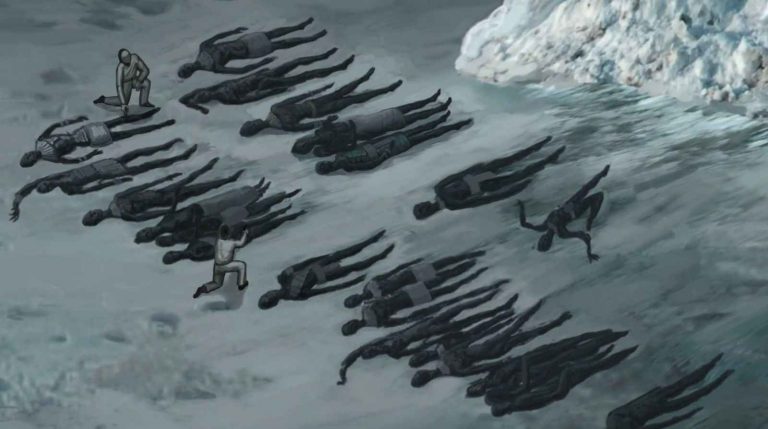
#Antarctica flashfrozen skin
The cold quickly anesthetizes the few square inches of exposed skin on our cheeks, and as the dive wears on, it intrudes into our suits and gloves, biting harder and harder. Moving is a struggle, swimming almost impossible. It feels like we’re learning to dive all over again. When at last we’re ready to topple into the freezing water, we’re wearing and carrying 200 pounds each. The brown patches above are microalgae, which cling to sea ice and photosynthesize in the spring. Just getting into our suits takes an hour and the help of Emmanuel Blanche, our emergency doctor.Ī diver watches an emperor penguin as it swims nearby. We look like astronauts minus the bubble helmets. There are two batteries for the heated bodysuit, a rebreather to remove carbon dioxide from our exhalations (allowing us to dive longer), backup gas cylinders, and finally, my photography equipment. There’s a hood as well as an underhood, waterproof gloves and heated liners, fins, and 35 pounds of weights. Our suits have four layers: thermal underwear on the inside, followed by an electrically heated bodysuit, a thick fleece, and a half-inch-thick layer of waterproof neoprene. So we drop a luminescent yellow rope into the hole and pull it along with us during the dive. Seals, when they need air, somehow find their way back to their hole our greatest dread is getting lost and trapped under the ice. Where we can’t slide into holes left by Weddell seals and their busy teeth, we dig our own with an ice-drilling machine. The preparations for each day’s dive take about as long. With our improved equipment we could last up to five hours.

(Salt water remains liquid below freshwater’s freezing point of 32 degrees.) Without dry suits we’d die in as little as 10 minutes. The water was going to be colder than 29 degrees Fahrenheit. We worked with manufacturers to identify the weak points of classic diving suits. On a map of the Adélie Coast pinned to my wall, I chose dive sites that had a range of bottom depths and were within six miles or so of Dumont d’Urville. Here we’ll be diving deeper than anyone has dived before under Antarctic ice-and the conditions will be beyond harsh.Īt home in France we spent two years preparing.


But this expedition to Antarctica is unlike any other. I’ve dived to 400 feet off South Africa to photograph rare coelacanths, and for 24 straight hours off Fakarava, in French Polynesia, to witness the mating of 17,000 groupers. Later, a craving for new mysteries took me elsewhere. I’ve worked for decades as a deep-diving photographer, at first in the Mediterranean Sea, where I learned to dive 30 years ago. (Read more: Get an Amazing Whale's-Eye View Underneath Antarctica) For 36 days, as the ice breaks up and retreats to within a few miles of the coast, we’ll dive through it, down as deep as 230 feet. In the winter the ice reaches 60 miles out to sea here, but we’ve come in October 2015, at the beginning of spring. While Jacquet films emperor penguins and Munier photographs them, my team will document life under the sea ice. I’ve come here with another photographer, Vincent Munier, at the invitation of filmmaker Luc Jacquet, who’s working on a sequel to his 2005 triumph, March of the Penguins. These bell-shaped plankton-eaters avoid direct light, which can kill them. Today’s dive is over-but it’s only one of 32.Ī bioluminescent crown jellyfish, some 14 inches wide, floats by at 130 feet deep, glowing and trailing a dozen stinging tentacles. Finally a hand grabs mine and hauls me into the air. Suddenly I’m stunned by a sharp blow to the head: Cédric Gentil, one of my dive buddies, is trying to dig me out, and his shovel has struck my skull. Grabbing the safety rope, I pull myself up inch by inch, but my shoulders get stuck. By the time I thrust one arm into the icy mush, it’s three feet thick. They’re converging on the hole as if it were an upside-down drain.

The bottom surface of the sea ice is a thick slurry of floating ice crystals, and my descent has set them in motion. The hole has already begun to close behind me. As I plunge at last into the icy water, I look back-to a sickening sight. Pushing and pulling with hands, knees, heels, and the tips of my swim fins, I shimmy through the hole. We’ve never tried to dive through such a small opening. It’s just wide enough for a man, and below it lies the sea. The hole goes right through the 10-foot-thick ice floe. In the morning, when we arrive on foot from Dumont d’Urville, the French scientific base on the Adélie Coast of East Antarctica, we have to break up a thin layer of ice that has formed over the hole we drilled the day before. This story appears in the July 2017 issue of National Geographic magazine.


 0 kommentar(er)
0 kommentar(er)
